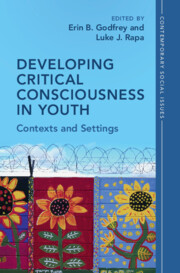Book contents
- Developing Critical Consciousness in Youth
- Contemporary Social Issues Series
- Developing Critical Consciousness in Youth
- Copyright page
- Dedication
- Contents
- Figures
- Tables
- Contributors
- Acknowledgments
- Introduction
- Part I Pedagogical, Curricular, and School-Based Contexts
- Part II Extracurricular Contexts
- Part III Societal Contexts
- 7 Critical Race Consciousness
- 8 The Quest for Racial Justice
- 9 Critical Consciousness Development among Undocumented Youth
- 10 Influences of Sense of Social Responsibility, Immigrant Bargain, and Immigrant Optimism on Critical Consciousness Development among Immigrant Youth of Color
- Concluding Thoughts on the Role of Contexts and Settings in Youth Critical Consciousness Development
- Index
- References
7 - Critical Race Consciousness
Conceptualizing a Model of Race-Specific Critical Consciousness among Youth
from Part III - Societal Contexts
Published online by Cambridge University Press: 11 May 2023
- Developing Critical Consciousness in Youth
- Contemporary Social Issues Series
- Developing Critical Consciousness in Youth
- Copyright page
- Dedication
- Contents
- Figures
- Tables
- Contributors
- Acknowledgments
- Introduction
- Part I Pedagogical, Curricular, and School-Based Contexts
- Part II Extracurricular Contexts
- Part III Societal Contexts
- 7 Critical Race Consciousness
- 8 The Quest for Racial Justice
- 9 Critical Consciousness Development among Undocumented Youth
- 10 Influences of Sense of Social Responsibility, Immigrant Bargain, and Immigrant Optimism on Critical Consciousness Development among Immigrant Youth of Color
- Concluding Thoughts on the Role of Contexts and Settings in Youth Critical Consciousness Development
- Index
- References
Summary
Despite growing interest in antiracism efforts, a dearth of theoretical and empirical work that examines how youth develop beliefs and actions that challenge racism, or develop a critical race consciousness (CRC), remains. In this chapter, we propose an integrative model that articulates the nature and dynamics of youth CRC, which includes racism analysis, racial reflexivity, and antiracism action. First, we describe the nature of racism in the United States and explain how this system serves as a developmental context for youth CRC. Second, we integrate several bodies of research across diverse fields of study (e.g., liberation psychology, developmental psychology, sociology, social work) that ground our model, followed by an in-depth discussion of the model. Then we discuss psychological processes and social contexts that may facilitate or hinder CRC praxis and development. We conclude with recommendations for future CRC research and practice that may stimulate this developmental process.
Keywords
- Type
- Chapter
- Information
- Developing Critical Consciousness in YouthContexts and Settings, pp. 195 - 231Publisher: Cambridge University PressPrint publication year: 2023



